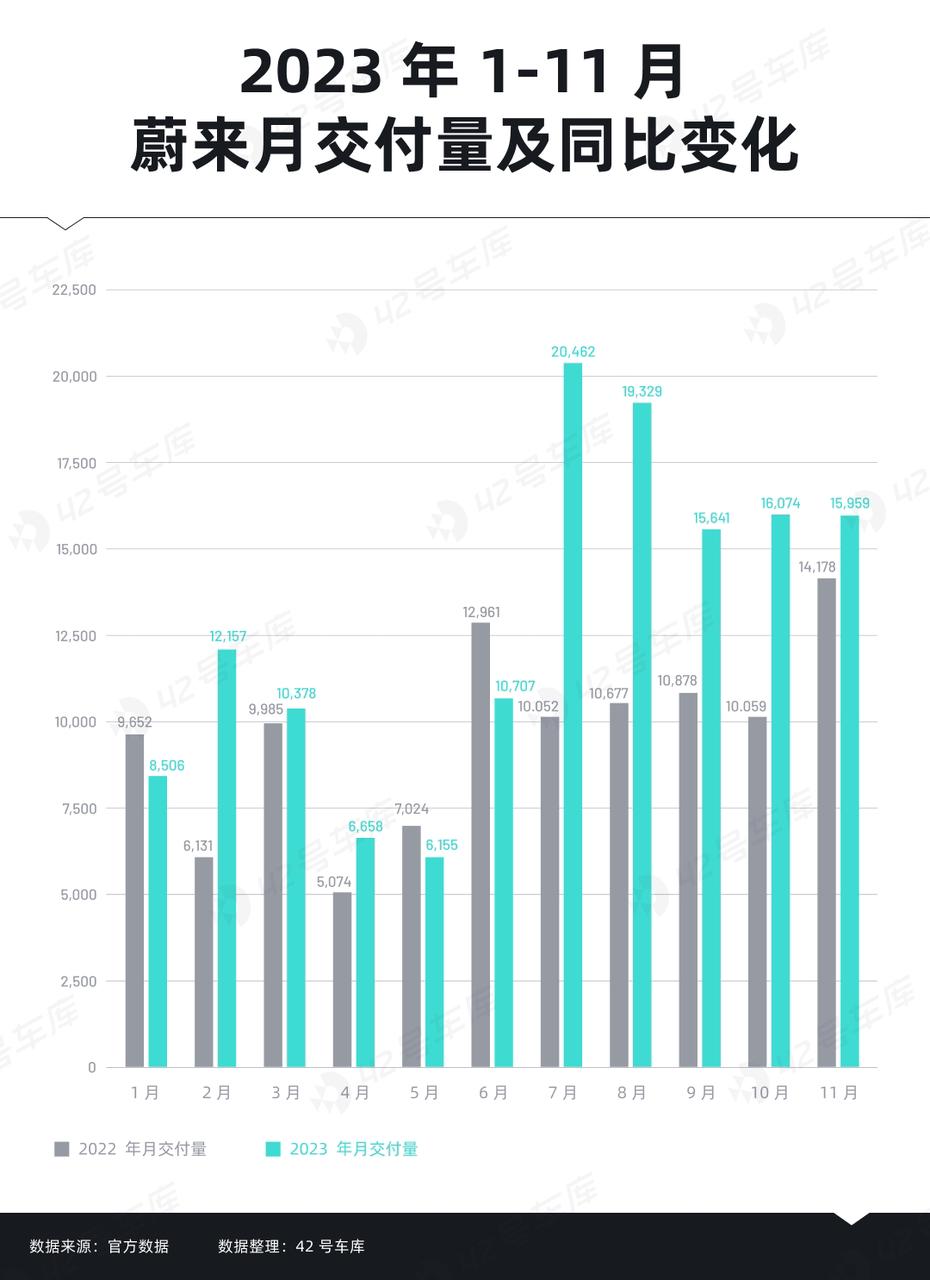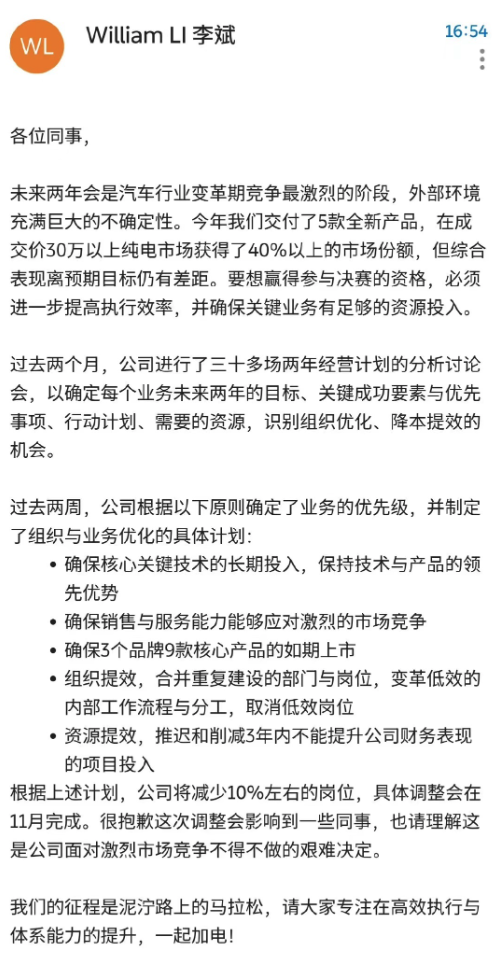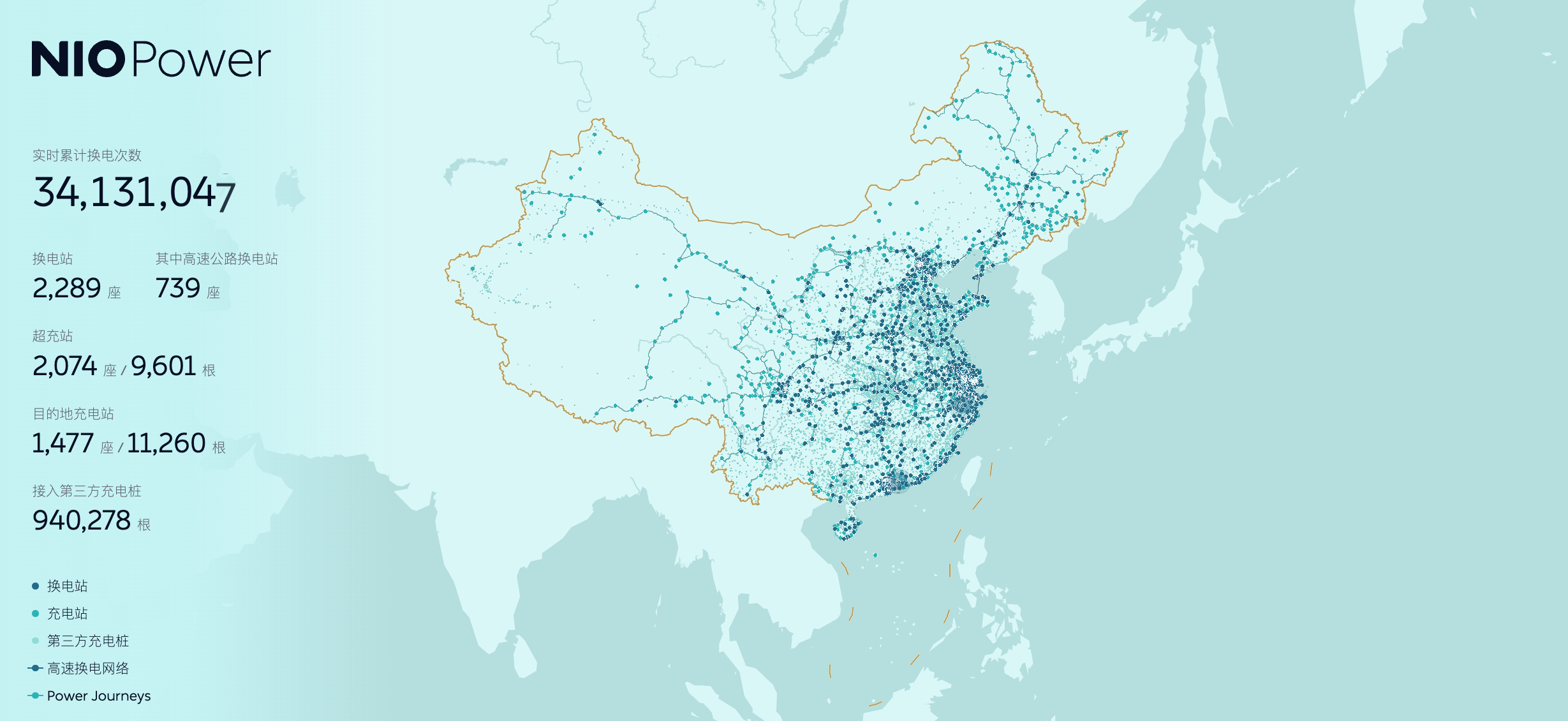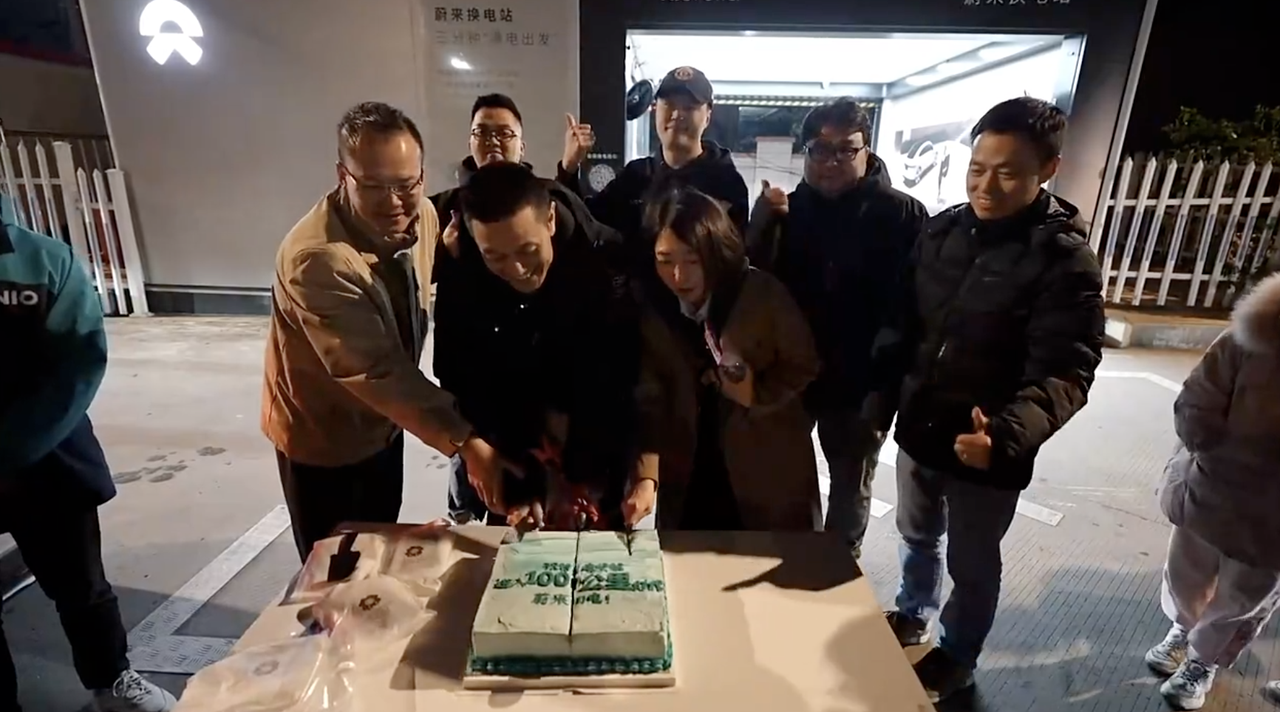On December 17, with the temperature at -2 degrees, Shanghai at 6:30 in the morning was in its early winter chill. While most might be lost in the world of dreams, William Li, CEO of NIO, was already driving his ET7 powered by a 150 kWh battery, heading south to begin a range test for which the distance was uncertain.
Undeterred by the unknown, Li set himself a challenging target, to surpass 1,000 km. However, the frigid -2 degrees weather stirred doubts about the feasibility of achieving this ambitious goal.
Yet, once having set off, there was no turning back. The live stream began, the viewers tuned in, and Li was committed to his adventure.
Ensuing, Li at times passionately expounded NIO’s strategies and values. Sometimes he turned into a presenter, leading the product introduction for NIO’s food research while having a bite himself. At other times, he reflected on stories from his childhood and personal life.
As ever, Li emphasized his steadfast pursuit of long-term values during his conversations, even if that meant tolerating significant pressure in the short term.
However, what has changed this time was Li’s growing impatience to improve NIO’s short-term operational efficiency. Just like when he chose to live stream the driving range of the 150 kWh battery, Li began taking more pragmatic and far-sighted actions to enhance short-term business efficiency.
A Live Stream That Mirrored NIO Itself
With only 3% of battery remaining, the ET7 powered by the 150 kWh battery had already covered a distance of 1,044 km. With around 800,000 viewers at peak times, Li had been live streaming for nearly 14 hours.
Despite the long hours, Li never showed signs of fatigue. Instead, his face beamed with joy and satisfaction—a victory hard to put into words.
As the outcome unfolded, Li had achieved his set target, and NIO officially announced on its WeChat that the ‘era of an intelligent EV with a range reaching 1,000 km’ had arrived. This live stream was undoubtedly a massive victory for NIO.
However, the process was not without bumps. Some issues encountered during the live stream were not promptly addressed. The live stream even ended abruptly while Li was talking to Chenxia Huang, General Manager of Tencent News operation.
In a sense, this 14-hour live stream, from dawn till dusk, was a reflection of NIO’s journey full of ups and downs in the new energy vehicle market.
First, there was no turning back for NIO’s long-term oriented operation approach, just like in this live stream.
Once the live stream began, under the watchful public eye, Li couldn’t stop unless the 150 kWh battery was depleted or close to empty. Indeed, all he could do was to maintain his momentum and move forward, either to achieve his target or to conclude in failure.
The same could be said for NIO’s long-term driven operation strategy.At present, NIO has invested heavily in charging and exchange systems, mobile phones, autonomous driving, services, and other areas, but these investments are unlikely to bring noticeable returns in the short term. If halted, this would imply the squandering of all previous efforts. Evidently, continuous investment is NIO’s only option if they hope to harvest the fruits of their efforts.
Further, this livestream has yet again exposed a recurring issue in NIO’s business decisions: clarity in strategy with ambiguity in tactics.
In terms of the arrangement of the entire livestream, NIO seemed singularly focused on achieving a breakthrough of a 1,000 km range but neglected to properly manage all aspects of the program.
During the livestream, for instance, multiple hiccups including an unexpected end to the livestream, a brief dispute between Li Bin and NIO’s deputy general manager Shen Fei about the use of NOP, and poor microphone quality due to being used while driving all hinted at a lack of thorough internal communication and emergency preparedness on NIO’s end.
Identical issues also surfaced in NIO’s growth. While NIO clearly grasps what it wants in its strategy, a variety of problems tend to arise in the implementation of tactics.
For example, despite exceeding their competitors in R&D funds, they have hardly any technical labels; the sales of ET7 slumped profoundly due to production capacity upon its hype; they fell behind in sales capability just when sales were barely topping 20,000.

Finally, within the livestream, Li Bin discussed a wide range of topics, including the product, management, personal growth, business enlightenment, photovoltaics and controllable nuclear fusion, and the impact of bipartisan politics in the US on the automotive industry.
Through Li Bin’s conversation, it’s evident that he’s a man rooted in idealism, cares and is aware about a vast array of issues, and has grand, long-term goals, as he put it during the livestream:
No entrepreneur hopes to be a martyr, yet they wouldn’t want to conduct their business only for the sake of business.
This sheds light on why Li Bin is so passionate about building NIO’s extensive product-service ecosystem and his fervor for long-term values.
However, despite his unchanged pursuit of long-term values, Li Bin also indicated that he’s begun emphasizing in the company not to let long-termism be a hindrance to short-term execution efficiency.
When Li Bin Starts to Focus on the Short-Term
Don’t call NIO a long-termist company, which could lull our colleagues into complacency. Instead, say that NIO is a company that pursues short-term execution. That sounds much better.
Li Bin said this to us at a NIO media face-to-face event on December 14.
Even though Li Bin doesn’t want NIO to be regarded as a long-termist company anymore, one undeniable fact remains: The long-term values that NIO, a nine-year-old company, has built are starting to kick in, especially in terms of battery swapping.At the end of March this year, at the China EV100 Forum, Li Bin announced that NIO’s battery swap system has reached a stage where it can be exported, and he is in negotiations for collaboration with several major manufacturers.
As expected, by November, NIO had announced its collaboration with Changan Auto and Geely Holding for its battery swap business, injecting a significant boost.
Although the battery swap business has escalated to a new level, it cannot be ignored that NIO remains mired in financial losses and slow sales growth amidst fierce market competition.
With inward and outward pressures, NIO’s immense system, established over nine years, is at a crucial moment requiring swift exertion of force. This implies that the speed and efficiency of short-term business execution is critical for NIO.
In fact, in terms of boosting short-term business execution efficiency, in addition to the recent range test live broadcast, NIO has already made a number of market-visible changes.
On September 21, NIO held its inaugural Innovation Technology Day, showcasing NIO’s full-stack technical capabilities for the first time, highlighting NIO’s technological prowess and underlying logic of deploying research and development for profit growth.
On November 3, Li Bin issued an internal letter announcing a 10% staff reduction, removing inefficient positions, delaying and reducing investment in projects that cannot boost the company’s financial performance in three years, and he unusually stressed the need to “further improve execution efficiency.”

On December 5, NIO, in its Q3 earnings report, mentioned that it has signed a definitive agreement to acquire a factory from JAC for ¥3.16 billion, an action that will help NIO reduce manufacturing costs by 10%.
Of course, it will take some time to see how much value these changes can bring to NIO. However, the execution efficiency of NIO’s intelligent driving is obviously high.
On December 12, NIO’s VP of Autonomous Driving R&D, Ren Shaoqing, announced that NIO’s urban pilot route validation mileage has reached 195,270 km. They are confident that they can complete 250,000 km of urban pilot route validation by the end of the year, while the original target was only to open 60,000 km in this quarter.
This is not only the result of improved short-term execution efficiency but also the outcome of NIO’s long-term focus on R&D and technological groundwork, as Li Bin put it:
Building a skyscraper like the Shanghai Tower requires substantial time spent on solidifying the foundation.
Facing the future, Li Bin is actually seeking a balance between long-term value and short-term business performance. The path to balance is clear — slim down and muscle up to improve gross margin.
During NIO’s face-to-face media event, Li Bin elaborated his thoughts and plans.In a bid to rapidly boost gross margins, NIO’s management is becoming more meticulous. The most evident step is the axing of the heavy-asset battery business. Additionally, Li Bin, the CEO, is demanding more in-depth consideration of fundamental logic during project initiation, whether in marketing or R&D, and insists on detailed calculation of return on investment.
On the product front, NIO’s secondary brand to be launched next year aims to capture the family market, addressing a wider consumer base and thus boosting sales. However, Li Bin emphasizes that the introduction of this secondary brand isn’t because of losses, but an attempt to monetize investments in intelligence by expanding sales volume.
Moreover, NIO’s risk estimation is becoming more conservative. Li Bin stated:
We have often developed five-year strategic plans since the end of 2019, but this year it’s cut down to two. Strategy discussions often involve spending, and if results aren’t as expected, there would be significant operational risks since the money has already been spent.
While emphasizing short-term execution, NIO remains committed to its core value of long-termism.
Regarding brand building, NIO continues to uphold its positioning as a high-end brand. Li Bin assured that NIO’s price will continue to rise, and one shouldn’t expect a car cheaper than the ET5. They plan to delve into the high-end business market with their administrative flagship model ET9, further solidifying NIO’s high-end positioning.

About battery swapping, Li Bin believes it’s NIO’s moat. As battery swapping networks grow, and more partners are involved, the moat deepens.
Interestingly, Li Bin also mentioned smartphones, believing that it would take three years to evaluate if NIO’s entry into the smartphone market is a worthy move. “As Huawei, XiaoMi, or even Apple increases its car sales, the significance of this initiative will be clear,” he added.
Li Bin has notably become more cautious and targeted in his thoughts, balancing long-termism and short-term business performance.
This attitude is echoed downward, as he advised colleagues not to have illusions about the fierce market competition and decisions made in exchange for volume.
Despite uncertainties, Li Bin remains optimistic, as he foresees electric vehicles will perform increasingly better with the improving charging and swapping network. Furthermore, he predicts that 2024 and 2025 will be explosive years for the high-end EV market. This implies that ample opportunities are awaiting NIO.
Therefore, NIO must adjust quickly now to seize opportunities in the next two years. Li Bin stated:
We’re surely more agile as an organization now, since every company has its inertia… However, we still have a way to go to be freely flexible.
Refined NIO needs aggressiveness
In a face-to-face communication session with the media, Qin Lihong, co-founder of NIO, said:We ask everyone to understand the true NIO. We hope to present ourselves with grace.
While elegance is fitting for a high-end brand, in the face of a cutthroat market, especially with continuous price wars, there is also a need for NIO to show some aggression along with its elegance.
In reality, this range test live broadcast subtly conveys NIO’s aggression.
Through this live broadcast, NIO has unquestionably communicated the product power of a max winter range exceeding 1,000 km with a 150 kWh battery.
Simultaneously, Li Bin live streamed for 14 continuous hours, without attacking competitors nor overly boasting. All there was driving, chatting, snacking, calling family, and mingling with NIO car owners. He did not only showed as the Chairman & CEO of NIO, but also as an industry thinker, traveler, friend, father, and more personal roles. This has been very beneficial for drawing fans for NIO and himself.

Interestingly, Li Bin mentioned during the live broadcast that NIO gets a lot of backlash, and he himself has taken a lot of criticism. In reality, Li Bin actually has become increasingly restrained, even stopping posting personal opinions on social media.
However, NIO’s current product strategy, battery swap service, mobile ecosystem, and many more aspects have been called into question, along with NIO’s development showing signs of fatigue. NIO urgently needs Li Bin himself to step up and speak out now.
An important fact to add here is that while previous years’ main speakers at media face-to-face events were Qin Lihong, this year it was Li Bin. Three days later, Li Bin went on to host the range test live broadcast.
Perhaps, NIO is trying to send a signal to the market that it’s gathering forces from top to bottom, using practical tactics to balance long-term value and short-term performance, standing in the market with elegance and aggression.
Coincidentally, on the next day after the live broadcast, NIO announced a new strategic investment of about 2.2 billion dollars from Abu Dhabi’s CYVN.
A series of facts demonstrate that NIO still has a lot of cards to play in face of harsh present and uncertain future.
This article is a translation by AI of a Chinese report from 42HOW. If you have any questions about it, please email bd@42how.com.
